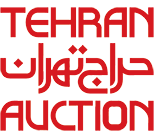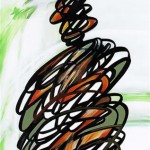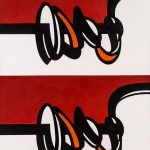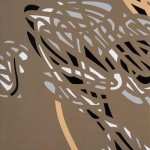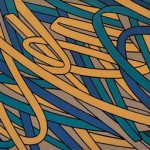The most recognizable works of KouroshShishegaran are his abstract portraits full of emotion and artistic expression with their ever-shifting limits and spiraling inner energy. Without a doubt, the great part of this force and emotion is due to the colorful dynamic waves of its intertwining, vibrating ribbons. This painting is a good example of his work in this area. The bicolored background of green and gray reflect the colorful ribbons of the portrait and at the same time hint at a dynamic feeling that went into these apparently mockingly drawn thick lines. The black ribbon among the colored ones not only clarifies the subject, it emphasizes the energetic illusion of the composition. The lines, left unfinished in places, liberate the visible energy of the intertwining ribbons on the surface. A tempestuous force, as if it were a storm out of control, flows across the canvas. This force is recognizable in the majority of Shishegaran’s portraits.
This process of drawing lines over and over has become a way for us to let off steam. It goes back to the first attempts at cave art and is perhaps the most childlike of styles. This is an inner process that thrusts vibrating infinite lines across the length of the canvas. KouroshShishegaran, at the height of his career, to which this painting belongs, chooses this ancient human experience as the subject of his work. Wild lines that disregard their point of origin or destination are unleashed and create a graphic space within the spirals in the painting. The visual space in this work is basically abstract, yet vague faces or images pop out of the tangle of lines. Yet what dominates the vague images or abstract images is the flooding of soft and flowing lines, brimming with energy and dynamism which have come to symbolize a champion of contemporary Iranian art.
In the 60’s the trend of ‘strip painting’ appeared in the hub of modern art, New York, and calligraphy art was an integral part of it. This style was solely based on the visual aspect of the artwork and the energy from the fluid movement of lines.
The works of KouroshShishegaran are basically a form of this linear or ribbon-like calligraphy art and we can now state that they were influential in the foundation of this style of modern art. The artistic nature of these works is based on the flood of lines on a plain background, untextured and free of expressionistic qualities. His brushwork and active choice of color are clearly undefinable, and perhaps are closer to graphic design and advertising. The borders of the lines and planes are decisive and separate from the fading colors on the edges and margins. It seems that the basic objective of the painting is to create multiple imagery and prodigious dynamics rather than pay attention to the inner composition of the work. In the end, what has been created, more than anything, is a visual emotion that needs to be seen; a ‘visual extraction’ sans literary or professional over-explanation.
Shishegaran’s ‘calligraphy art’ clearly distinguishes itself from American ‘strip art,’ perhaps due to his connection to Iran. The main difference is that his work,in a major way, takes what is basically an abstract painting and steers it toward the figurative. In his well-known works, as well as the one on display here, the portrayal of the human form takes shape within the flow of tangled lines. As a result, his paintings traverse the struggle between abstract and figurative. The images that appear in this way, contrary to the modern semi-abstract portraits, lack an effective emotional and psychological feel, and instead bring out a human narrative, through accenting the ‘structure’ of the image and abstraction. The artist often stated that he chose abstract art to avoid any personal narration of humanity. He chose abstraction so that the observers themselves could be the judges and critics of his work. “I always wondered why portraits were never painted abstractly. An abstract portrait gives the artist complete freedom to look beyond the subject and perceive it symbolically. There are unspoken secrets in every face that, if brought to light, allow the portrait to be drawn on a different level; a level much more interesting than the evident one. Any artists, who sit to capture a face, will find their own personal style to express what concerns them.”*
This quote clarifies his point of view that an artist is basically an intermediary to induce something in the observer. By choosing to portray a figure abstractly, in reality, the artist is clearly determined to negate his place as a narrator of the work and to distance himself from imposing the subject upon the observer’s opinion. It is the presentation of an abstract figure without any personal or psychological characteristics. In Shishegaran’sopinion art is whatever image the artist leaves in the observer’s mind. Yet it is clear that his subjects are captured in knotted coils of intertwining ribbons which we associate with conditions of oppression. We are left with the question of whether the style of portraying the human figure is nothing more than a painful expression of the human condition.
It should be added that a similar painting of Shishegaran’s sold at Christie’s Dubai auction in 2007 for a record $161,000.
*Christie’s catalogue,31 October 2007, Dubai, p.101.
